Computation of Partnership Income and Tom's Taxable Income
VerifiedAdded on 2023/06/04
|8
|1376
|262
AI Summary
This article discusses the computation of partnership income and Tom's taxable income. It includes a table of contents, brief descriptions, workings, and references.
Contribute Materials
Your contribution can guide someone’s learning journey. Share your
documents today.
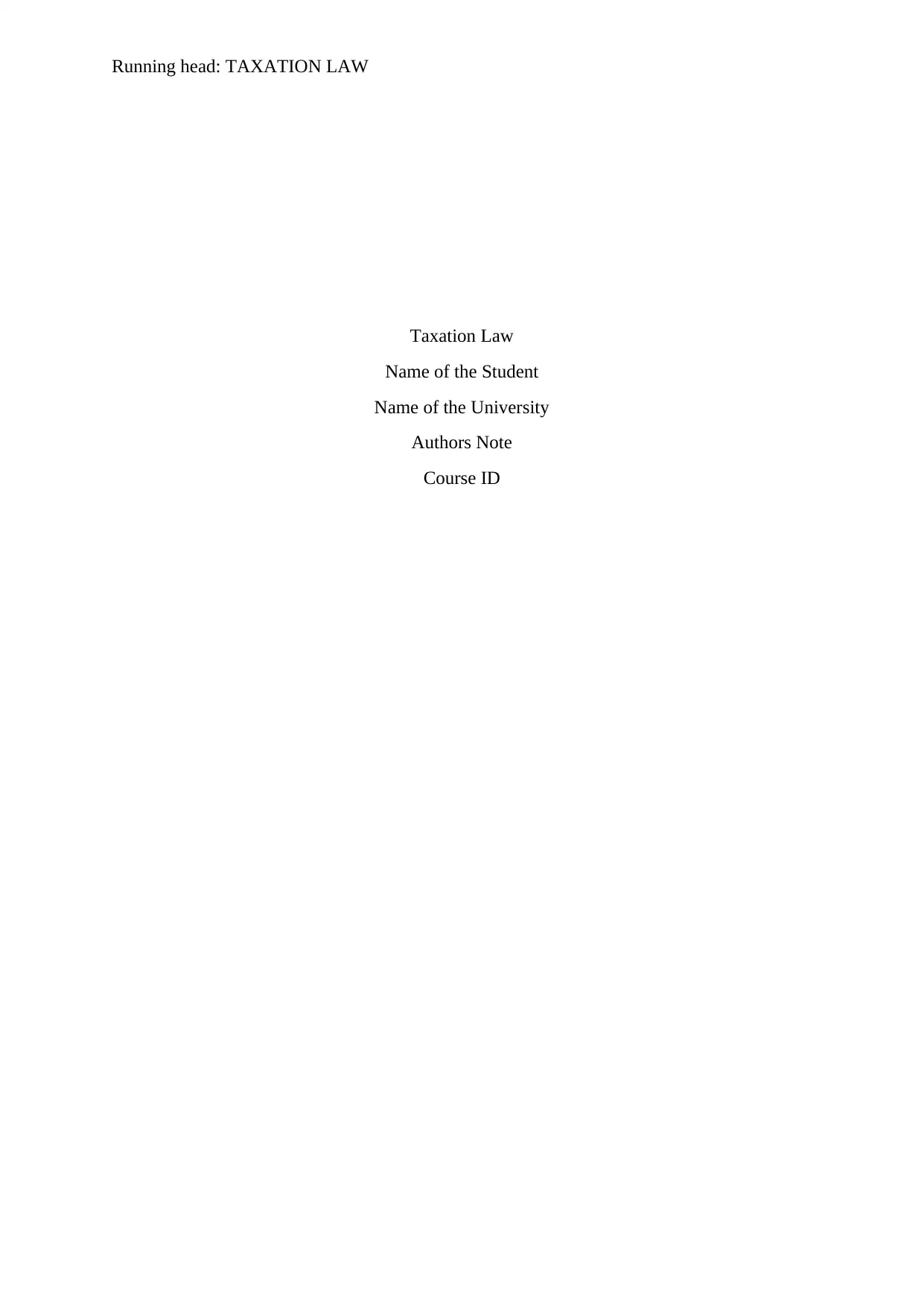
Running head: TAXATION LAW
Taxation Law
Name of the Student
Name of the University
Authors Note
Course ID
Taxation Law
Name of the Student
Name of the University
Authors Note
Course ID
Secure Best Marks with AI Grader
Need help grading? Try our AI Grader for instant feedback on your assignments.
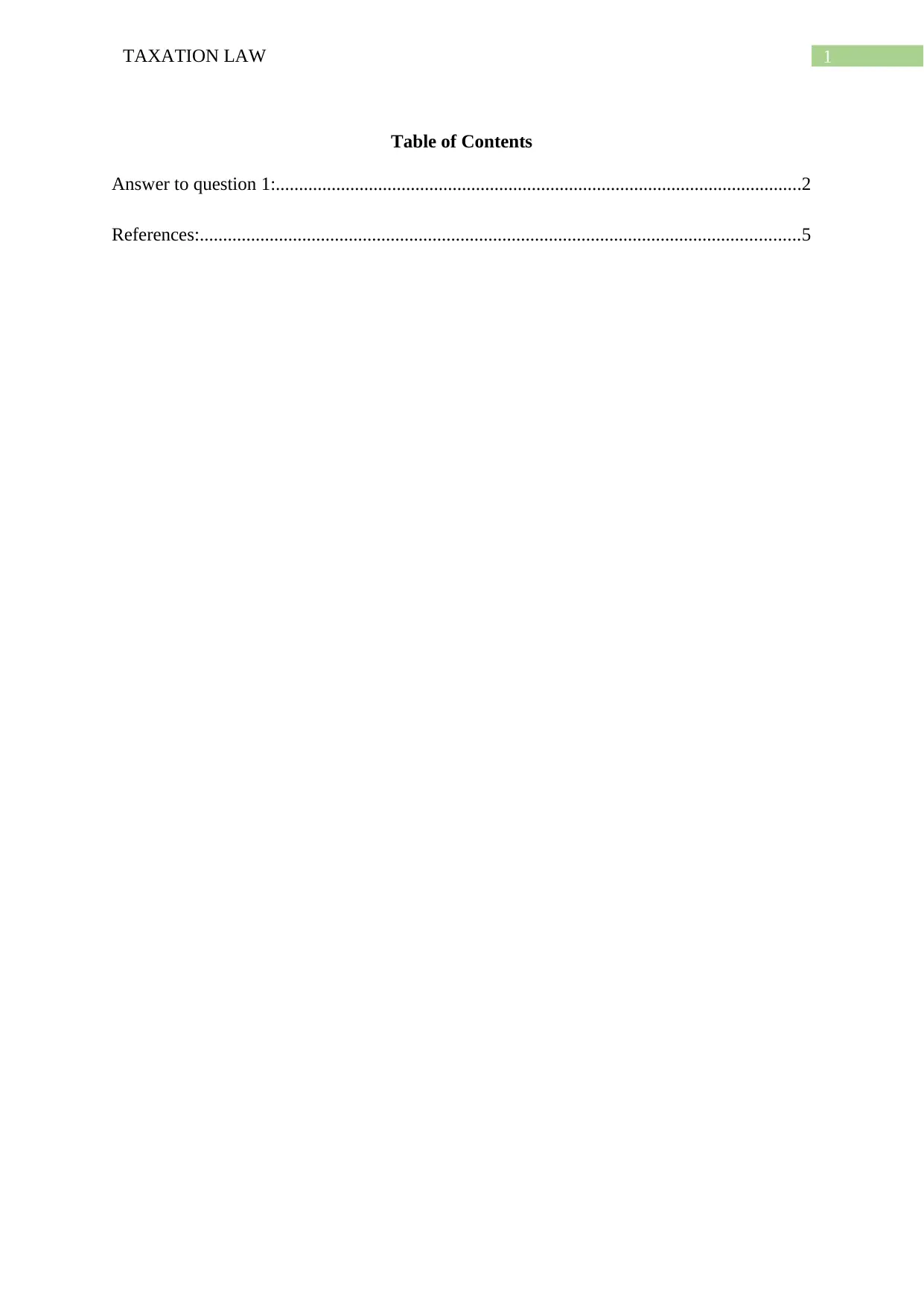
1TAXATION LAW
Table of Contents
Answer to question 1:.................................................................................................................2
References:.................................................................................................................................5
Table of Contents
Answer to question 1:.................................................................................................................2
References:.................................................................................................................................5
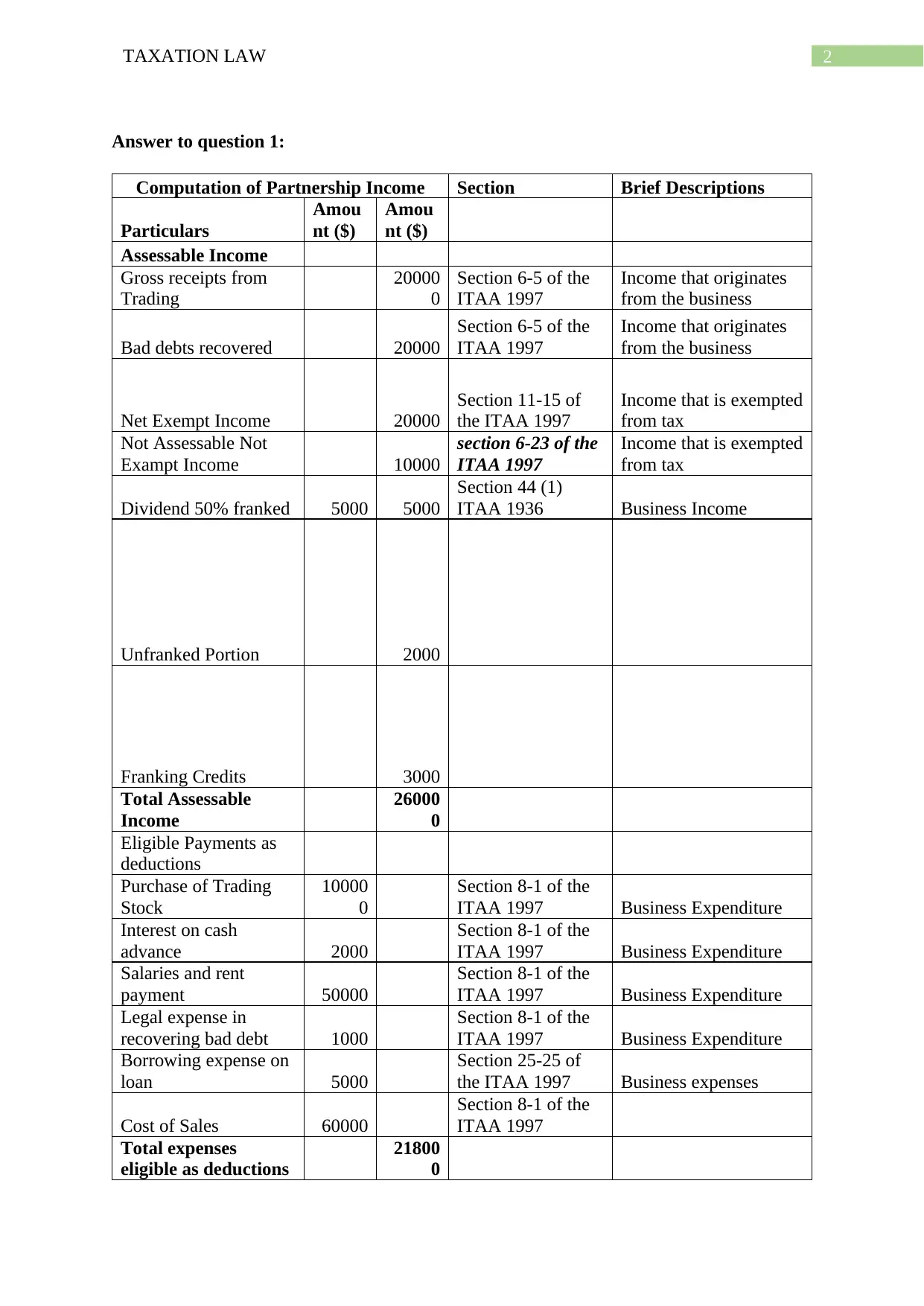
2TAXATION LAW
Answer to question 1:
Computation of Partnership Income Section Brief Descriptions
Particulars
Amou
nt ($)
Amou
nt ($)
Assessable Income
Gross receipts from
Trading
20000
0
Section 6-5 of the
ITAA 1997
Income that originates
from the business
Bad debts recovered 20000
Section 6-5 of the
ITAA 1997
Income that originates
from the business
Net Exempt Income 20000
Section 11-15 of
the ITAA 1997
Income that is exempted
from tax
Not Assessable Not
Exampt Income 10000
section 6-23 of the
ITAA 1997
Income that is exempted
from tax
Dividend 50% franked 5000 5000
Section 44 (1)
ITAA 1936 Business Income
Unfranked Portion 2000
Franking Credits 3000
Total Assessable
Income
26000
0
Eligible Payments as
deductions
Purchase of Trading
Stock
10000
0
Section 8-1 of the
ITAA 1997 Business Expenditure
Interest on cash
advance 2000
Section 8-1 of the
ITAA 1997 Business Expenditure
Salaries and rent
payment 50000
Section 8-1 of the
ITAA 1997 Business Expenditure
Legal expense in
recovering bad debt 1000
Section 8-1 of the
ITAA 1997 Business Expenditure
Borrowing expense on
loan 5000
Section 25-25 of
the ITAA 1997 Business expenses
Cost of Sales 60000
Section 8-1 of the
ITAA 1997
Total expenses
eligible as deductions
21800
0
Answer to question 1:
Computation of Partnership Income Section Brief Descriptions
Particulars
Amou
nt ($)
Amou
nt ($)
Assessable Income
Gross receipts from
Trading
20000
0
Section 6-5 of the
ITAA 1997
Income that originates
from the business
Bad debts recovered 20000
Section 6-5 of the
ITAA 1997
Income that originates
from the business
Net Exempt Income 20000
Section 11-15 of
the ITAA 1997
Income that is exempted
from tax
Not Assessable Not
Exampt Income 10000
section 6-23 of the
ITAA 1997
Income that is exempted
from tax
Dividend 50% franked 5000 5000
Section 44 (1)
ITAA 1936 Business Income
Unfranked Portion 2000
Franking Credits 3000
Total Assessable
Income
26000
0
Eligible Payments as
deductions
Purchase of Trading
Stock
10000
0
Section 8-1 of the
ITAA 1997 Business Expenditure
Interest on cash
advance 2000
Section 8-1 of the
ITAA 1997 Business Expenditure
Salaries and rent
payment 50000
Section 8-1 of the
ITAA 1997 Business Expenditure
Legal expense in
recovering bad debt 1000
Section 8-1 of the
ITAA 1997 Business Expenditure
Borrowing expense on
loan 5000
Section 25-25 of
the ITAA 1997 Business expenses
Cost of Sales 60000
Section 8-1 of the
ITAA 1997
Total expenses
eligible as deductions
21800
0
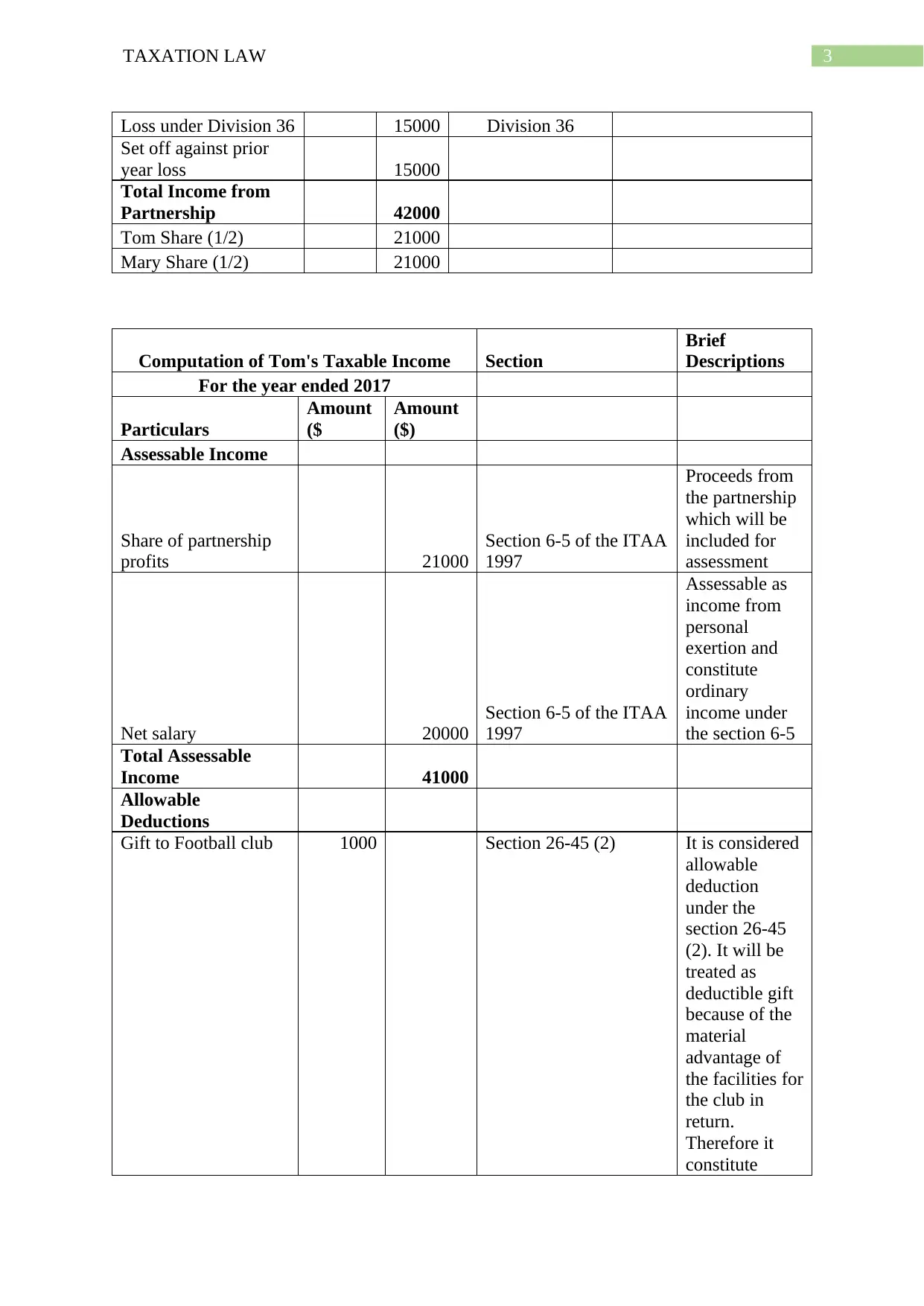
3TAXATION LAW
Loss under Division 36 15000 Division 36
Set off against prior
year loss 15000
Total Income from
Partnership 42000
Tom Share (1/2) 21000
Mary Share (1/2) 21000
Computation of Tom's Taxable Income Section
Brief
Descriptions
For the year ended 2017
Particulars
Amount
($
Amount
($)
Assessable Income
Share of partnership
profits 21000
Section 6-5 of the ITAA
1997
Proceeds from
the partnership
which will be
included for
assessment
Net salary 20000
Section 6-5 of the ITAA
1997
Assessable as
income from
personal
exertion and
constitute
ordinary
income under
the section 6-5
Total Assessable
Income 41000
Allowable
Deductions
Gift to Football club 1000 Section 26-45 (2) It is considered
allowable
deduction
under the
section 26-45
(2). It will be
treated as
deductible gift
because of the
material
advantage of
the facilities for
the club in
return.
Therefore it
constitute
Loss under Division 36 15000 Division 36
Set off against prior
year loss 15000
Total Income from
Partnership 42000
Tom Share (1/2) 21000
Mary Share (1/2) 21000
Computation of Tom's Taxable Income Section
Brief
Descriptions
For the year ended 2017
Particulars
Amount
($
Amount
($)
Assessable Income
Share of partnership
profits 21000
Section 6-5 of the ITAA
1997
Proceeds from
the partnership
which will be
included for
assessment
Net salary 20000
Section 6-5 of the ITAA
1997
Assessable as
income from
personal
exertion and
constitute
ordinary
income under
the section 6-5
Total Assessable
Income 41000
Allowable
Deductions
Gift to Football club 1000 Section 26-45 (2) It is considered
allowable
deduction
under the
section 26-45
(2). It will be
treated as
deductible gift
because of the
material
advantage of
the facilities for
the club in
return.
Therefore it
constitute
Secure Best Marks with AI Grader
Need help grading? Try our AI Grader for instant feedback on your assignments.
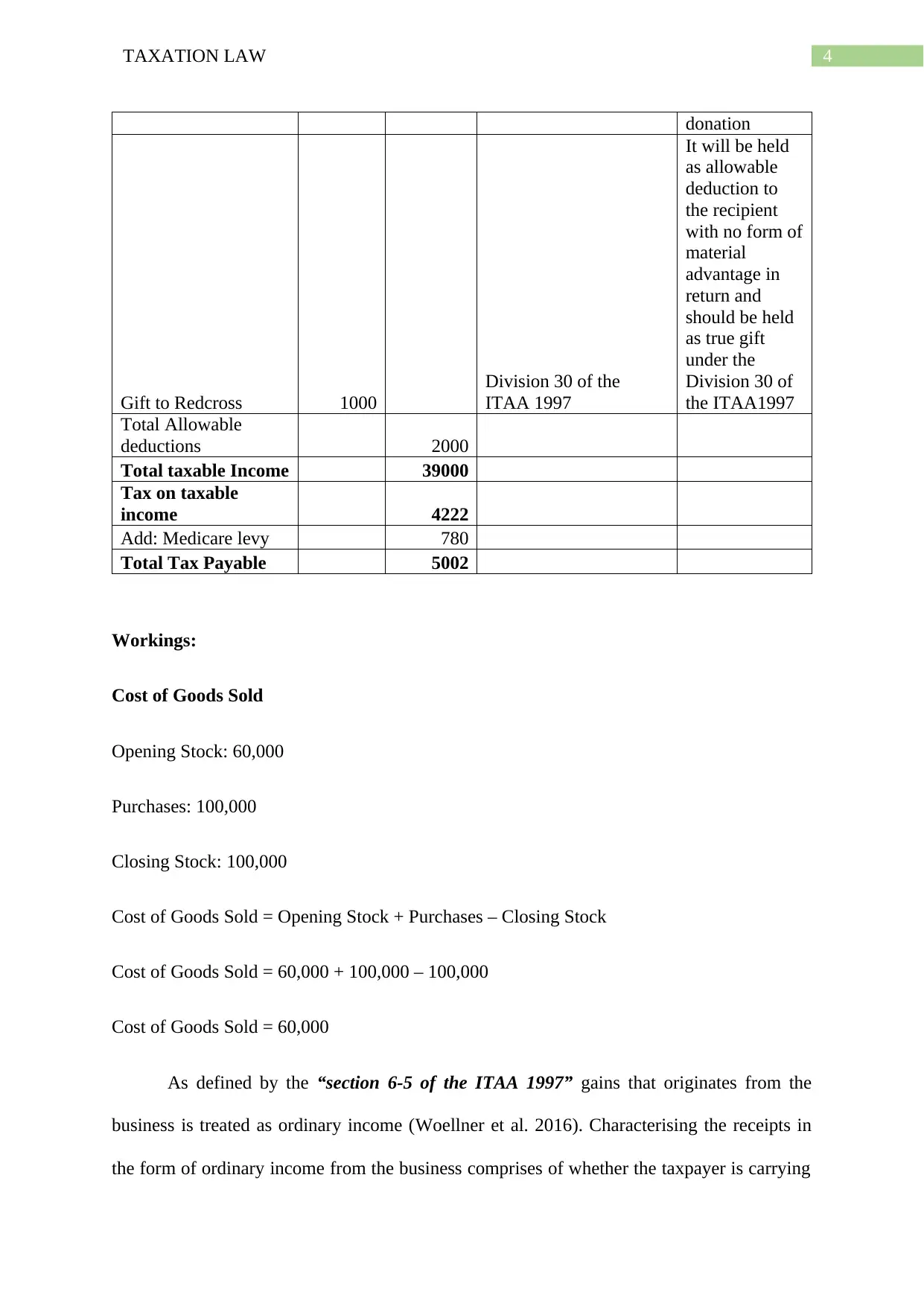
4TAXATION LAW
donation
Gift to Redcross 1000
Division 30 of the
ITAA 1997
It will be held
as allowable
deduction to
the recipient
with no form of
material
advantage in
return and
should be held
as true gift
under the
Division 30 of
the ITAA1997
Total Allowable
deductions 2000
Total taxable Income 39000
Tax on taxable
income 4222
Add: Medicare levy 780
Total Tax Payable 5002
Workings:
Cost of Goods Sold
Opening Stock: 60,000
Purchases: 100,000
Closing Stock: 100,000
Cost of Goods Sold = Opening Stock + Purchases – Closing Stock
Cost of Goods Sold = 60,000 + 100,000 – 100,000
Cost of Goods Sold = 60,000
As defined by the “section 6-5 of the ITAA 1997” gains that originates from the
business is treated as ordinary income (Woellner et al. 2016). Characterising the receipts in
the form of ordinary income from the business comprises of whether the taxpayer is carrying
donation
Gift to Redcross 1000
Division 30 of the
ITAA 1997
It will be held
as allowable
deduction to
the recipient
with no form of
material
advantage in
return and
should be held
as true gift
under the
Division 30 of
the ITAA1997
Total Allowable
deductions 2000
Total taxable Income 39000
Tax on taxable
income 4222
Add: Medicare levy 780
Total Tax Payable 5002
Workings:
Cost of Goods Sold
Opening Stock: 60,000
Purchases: 100,000
Closing Stock: 100,000
Cost of Goods Sold = Opening Stock + Purchases – Closing Stock
Cost of Goods Sold = 60,000 + 100,000 – 100,000
Cost of Goods Sold = 60,000
As defined by the “section 6-5 of the ITAA 1997” gains that originates from the
business is treated as ordinary income (Woellner et al. 2016). Characterising the receipts in
the form of ordinary income from the business comprises of whether the taxpayer is carrying
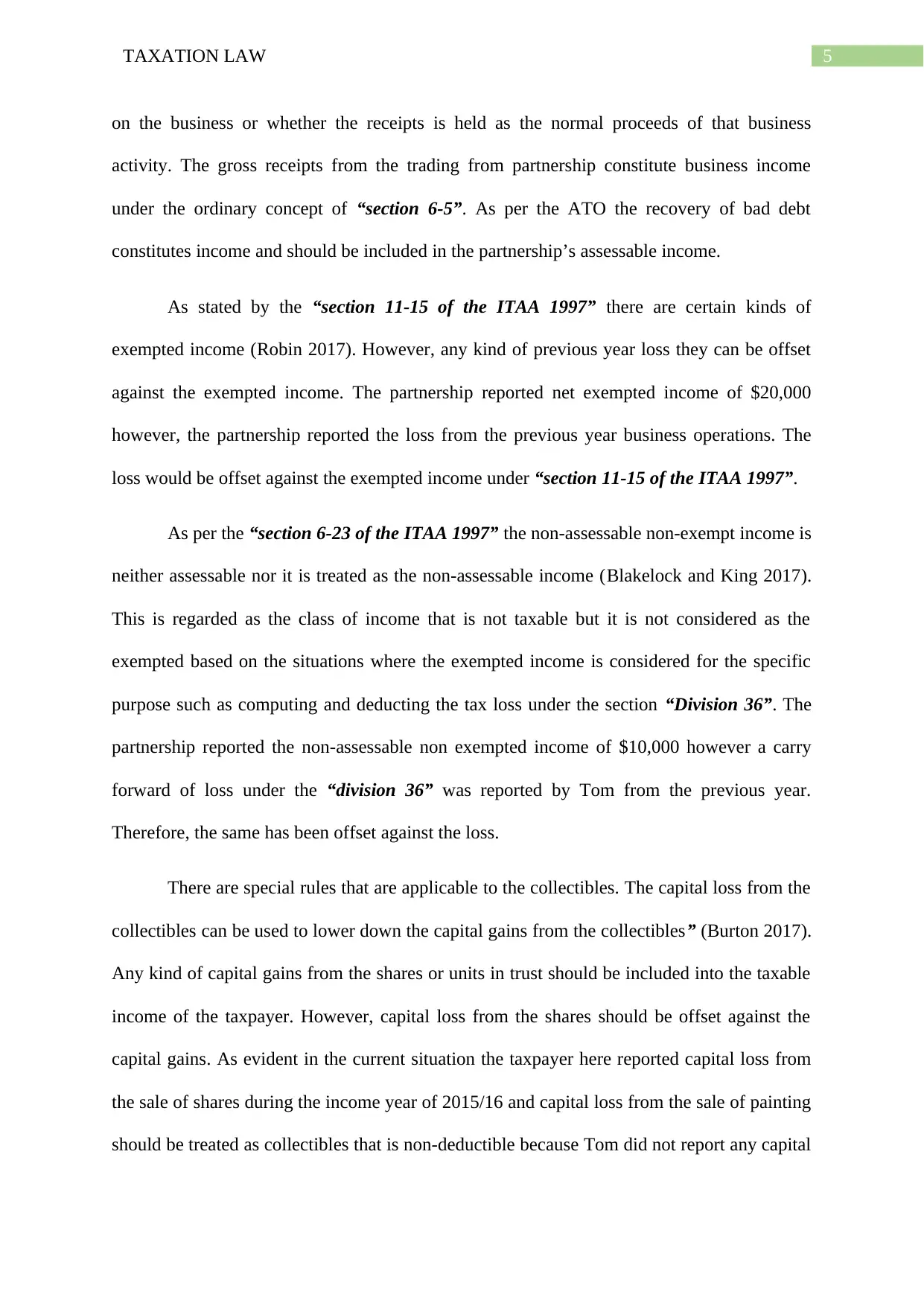
5TAXATION LAW
on the business or whether the receipts is held as the normal proceeds of that business
activity. The gross receipts from the trading from partnership constitute business income
under the ordinary concept of “section 6-5”. As per the ATO the recovery of bad debt
constitutes income and should be included in the partnership’s assessable income.
As stated by the “section 11-15 of the ITAA 1997” there are certain kinds of
exempted income (Robin 2017). However, any kind of previous year loss they can be offset
against the exempted income. The partnership reported net exempted income of $20,000
however, the partnership reported the loss from the previous year business operations. The
loss would be offset against the exempted income under “section 11-15 of the ITAA 1997”.
As per the “section 6-23 of the ITAA 1997” the non-assessable non-exempt income is
neither assessable nor it is treated as the non-assessable income (Blakelock and King 2017).
This is regarded as the class of income that is not taxable but it is not considered as the
exempted based on the situations where the exempted income is considered for the specific
purpose such as computing and deducting the tax loss under the section “Division 36”. The
partnership reported the non-assessable non exempted income of $10,000 however a carry
forward of loss under the “division 36” was reported by Tom from the previous year.
Therefore, the same has been offset against the loss.
There are special rules that are applicable to the collectibles. The capital loss from the
collectibles can be used to lower down the capital gains from the collectibles” (Burton 2017).
Any kind of capital gains from the shares or units in trust should be included into the taxable
income of the taxpayer. However, capital loss from the shares should be offset against the
capital gains. As evident in the current situation the taxpayer here reported capital loss from
the sale of shares during the income year of 2015/16 and capital loss from the sale of painting
should be treated as collectibles that is non-deductible because Tom did not report any capital
on the business or whether the receipts is held as the normal proceeds of that business
activity. The gross receipts from the trading from partnership constitute business income
under the ordinary concept of “section 6-5”. As per the ATO the recovery of bad debt
constitutes income and should be included in the partnership’s assessable income.
As stated by the “section 11-15 of the ITAA 1997” there are certain kinds of
exempted income (Robin 2017). However, any kind of previous year loss they can be offset
against the exempted income. The partnership reported net exempted income of $20,000
however, the partnership reported the loss from the previous year business operations. The
loss would be offset against the exempted income under “section 11-15 of the ITAA 1997”.
As per the “section 6-23 of the ITAA 1997” the non-assessable non-exempt income is
neither assessable nor it is treated as the non-assessable income (Blakelock and King 2017).
This is regarded as the class of income that is not taxable but it is not considered as the
exempted based on the situations where the exempted income is considered for the specific
purpose such as computing and deducting the tax loss under the section “Division 36”. The
partnership reported the non-assessable non exempted income of $10,000 however a carry
forward of loss under the “division 36” was reported by Tom from the previous year.
Therefore, the same has been offset against the loss.
There are special rules that are applicable to the collectibles. The capital loss from the
collectibles can be used to lower down the capital gains from the collectibles” (Burton 2017).
Any kind of capital gains from the shares or units in trust should be included into the taxable
income of the taxpayer. However, capital loss from the shares should be offset against the
capital gains. As evident in the current situation the taxpayer here reported capital loss from
the sale of shares during the income year of 2015/16 and capital loss from the sale of painting
should be treated as collectibles that is non-deductible because Tom did not report any capital
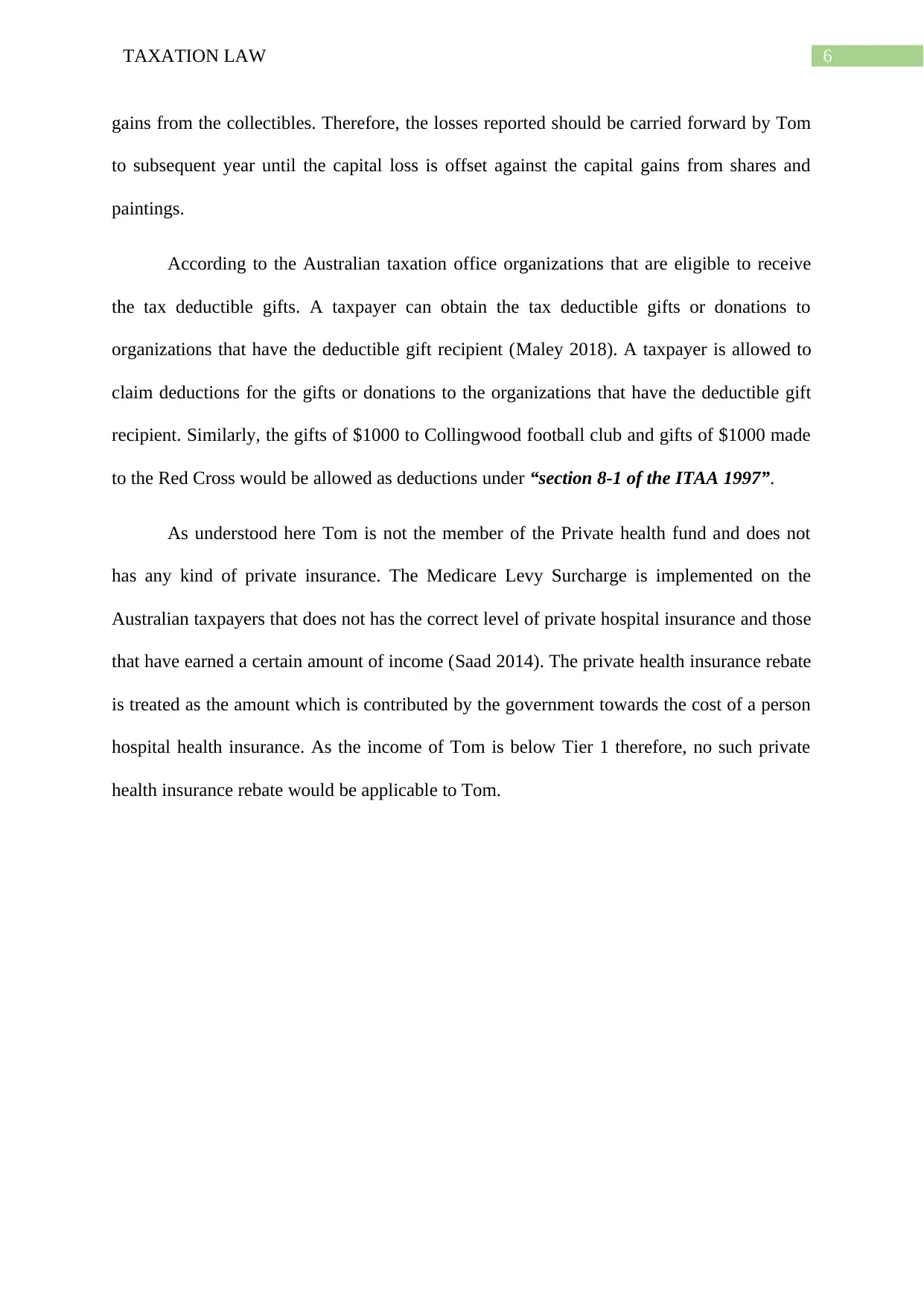
6TAXATION LAW
gains from the collectibles. Therefore, the losses reported should be carried forward by Tom
to subsequent year until the capital loss is offset against the capital gains from shares and
paintings.
According to the Australian taxation office organizations that are eligible to receive
the tax deductible gifts. A taxpayer can obtain the tax deductible gifts or donations to
organizations that have the deductible gift recipient (Maley 2018). A taxpayer is allowed to
claim deductions for the gifts or donations to the organizations that have the deductible gift
recipient. Similarly, the gifts of $1000 to Collingwood football club and gifts of $1000 made
to the Red Cross would be allowed as deductions under “section 8-1 of the ITAA 1997”.
As understood here Tom is not the member of the Private health fund and does not
has any kind of private insurance. The Medicare Levy Surcharge is implemented on the
Australian taxpayers that does not has the correct level of private hospital insurance and those
that have earned a certain amount of income (Saad 2014). The private health insurance rebate
is treated as the amount which is contributed by the government towards the cost of a person
hospital health insurance. As the income of Tom is below Tier 1 therefore, no such private
health insurance rebate would be applicable to Tom.
gains from the collectibles. Therefore, the losses reported should be carried forward by Tom
to subsequent year until the capital loss is offset against the capital gains from shares and
paintings.
According to the Australian taxation office organizations that are eligible to receive
the tax deductible gifts. A taxpayer can obtain the tax deductible gifts or donations to
organizations that have the deductible gift recipient (Maley 2018). A taxpayer is allowed to
claim deductions for the gifts or donations to the organizations that have the deductible gift
recipient. Similarly, the gifts of $1000 to Collingwood football club and gifts of $1000 made
to the Red Cross would be allowed as deductions under “section 8-1 of the ITAA 1997”.
As understood here Tom is not the member of the Private health fund and does not
has any kind of private insurance. The Medicare Levy Surcharge is implemented on the
Australian taxpayers that does not has the correct level of private hospital insurance and those
that have earned a certain amount of income (Saad 2014). The private health insurance rebate
is treated as the amount which is contributed by the government towards the cost of a person
hospital health insurance. As the income of Tom is below Tier 1 therefore, no such private
health insurance rebate would be applicable to Tom.
Paraphrase This Document
Need a fresh take? Get an instant paraphrase of this document with our AI Paraphraser
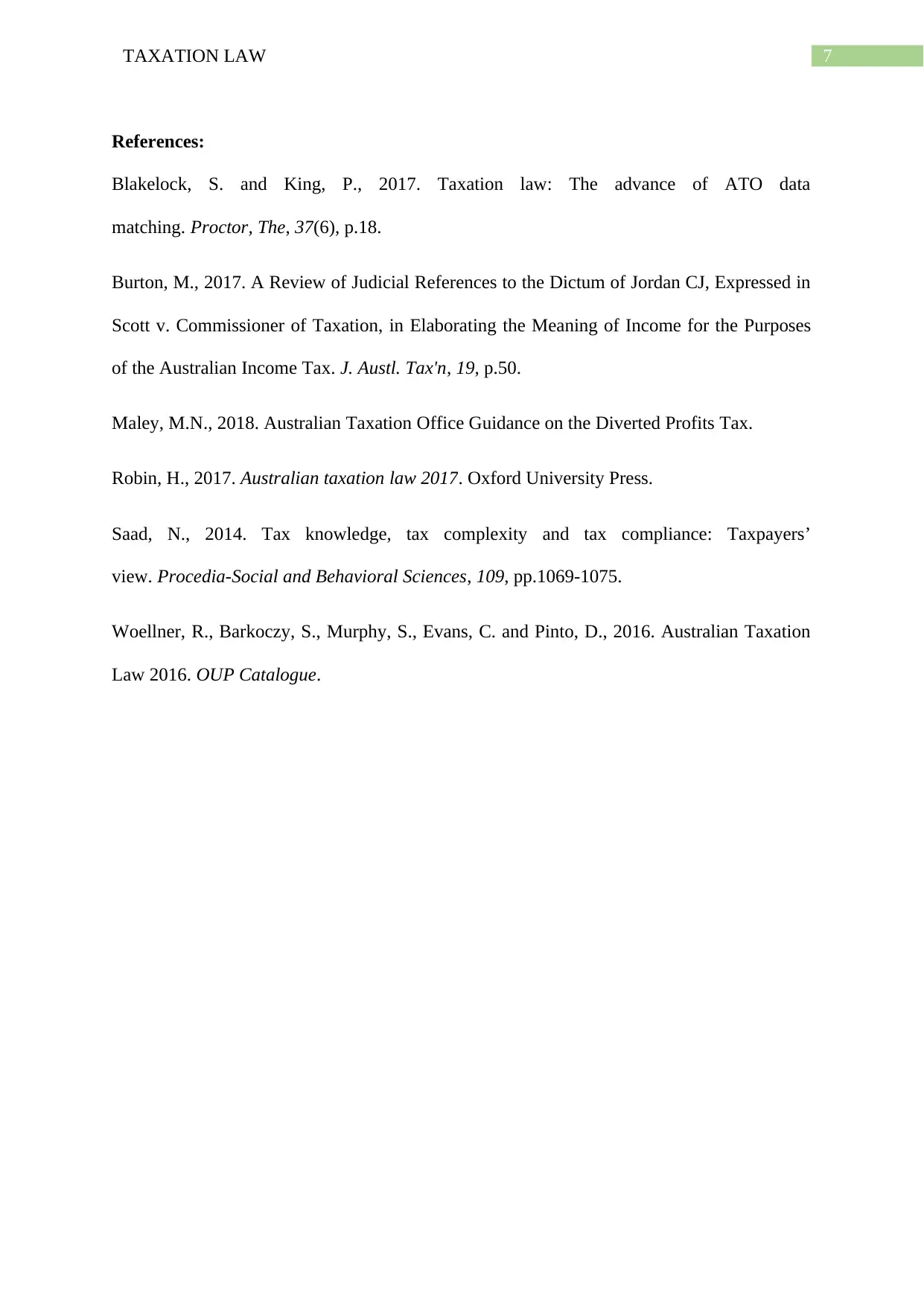
7TAXATION LAW
References:
Blakelock, S. and King, P., 2017. Taxation law: The advance of ATO data
matching. Proctor, The, 37(6), p.18.
Burton, M., 2017. A Review of Judicial References to the Dictum of Jordan CJ, Expressed in
Scott v. Commissioner of Taxation, in Elaborating the Meaning of Income for the Purposes
of the Australian Income Tax. J. Austl. Tax'n, 19, p.50.
Maley, M.N., 2018. Australian Taxation Office Guidance on the Diverted Profits Tax.
Robin, H., 2017. Australian taxation law 2017. Oxford University Press.
Saad, N., 2014. Tax knowledge, tax complexity and tax compliance: Taxpayers’
view. Procedia-Social and Behavioral Sciences, 109, pp.1069-1075.
Woellner, R., Barkoczy, S., Murphy, S., Evans, C. and Pinto, D., 2016. Australian Taxation
Law 2016. OUP Catalogue.
References:
Blakelock, S. and King, P., 2017. Taxation law: The advance of ATO data
matching. Proctor, The, 37(6), p.18.
Burton, M., 2017. A Review of Judicial References to the Dictum of Jordan CJ, Expressed in
Scott v. Commissioner of Taxation, in Elaborating the Meaning of Income for the Purposes
of the Australian Income Tax. J. Austl. Tax'n, 19, p.50.
Maley, M.N., 2018. Australian Taxation Office Guidance on the Diverted Profits Tax.
Robin, H., 2017. Australian taxation law 2017. Oxford University Press.
Saad, N., 2014. Tax knowledge, tax complexity and tax compliance: Taxpayers’
view. Procedia-Social and Behavioral Sciences, 109, pp.1069-1075.
Woellner, R., Barkoczy, S., Murphy, S., Evans, C. and Pinto, D., 2016. Australian Taxation
Law 2016. OUP Catalogue.
1 out of 8
Related Documents
Your All-in-One AI-Powered Toolkit for Academic Success.
+13062052269
info@desklib.com
Available 24*7 on WhatsApp / Email
![[object Object]](/_next/static/media/star-bottom.7253800d.svg)
Unlock your academic potential
© 2024 | Zucol Services PVT LTD | All rights reserved.


